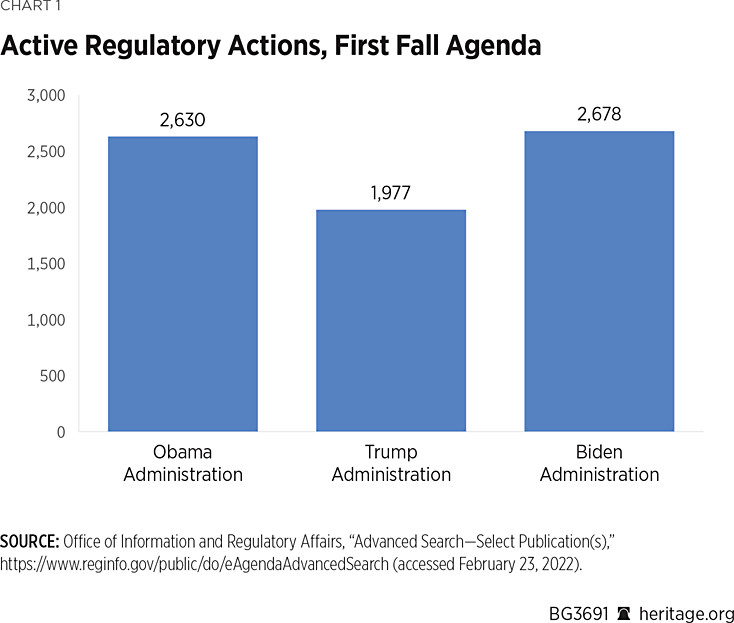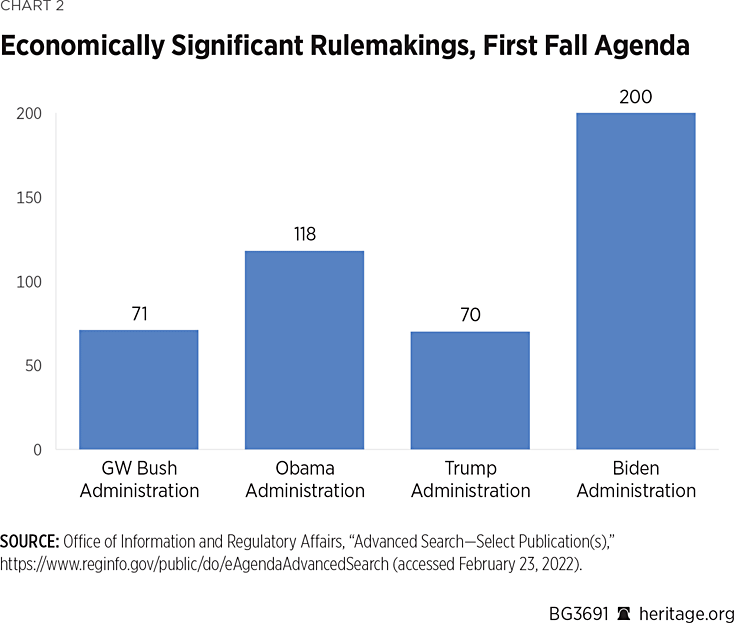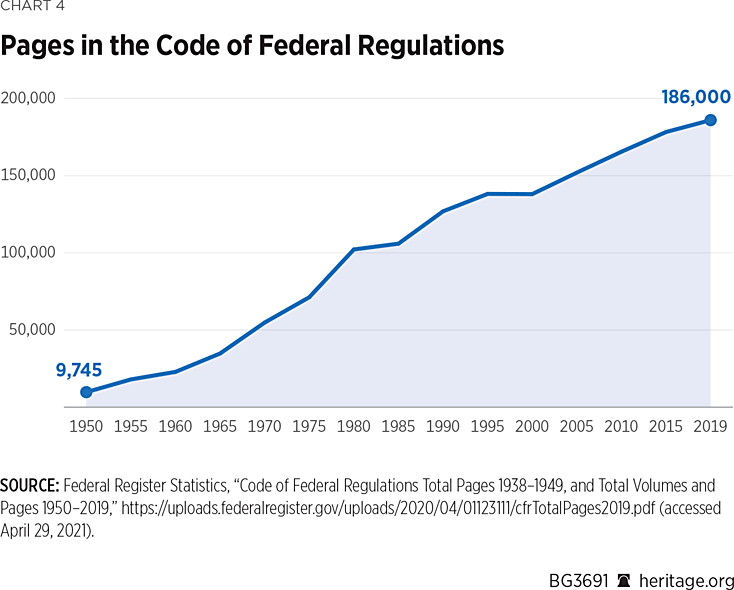The Biden Administration’s regulatory agenda for 2022 reveals complete indifference toward the social and economic chaos perpetrated to date by the President’s progressive policies. Few, if any, of the thousands of looming regulations are necessary or beneficial notwithstanding the enormous costs, and many will erode free enterprise and individual liberty.
Publication of this semiannual “Unified Agenda”REF is required by Executive Order 12866REF to provide public notice of rulemakings. Fall editions of the agenda are accompanied by agency statements of regulatory priorities, known collectively as the “Regulatory Plan.”REF
In its introduction to the latest plan, released on December 10, 2021, the White House boasts that federal agencies will “build on significant progress the Administration has already made advancing our priorities and proving that our Government can deliver results—from confronting the pandemic, to creating a stronger and fairer economy, to addressing climate change and advancing equity.”REF
As with so much of the Leftist manifesto, this conceit about government’s efficacy and beneficence is misguided. In actuality, the Biden Administration has failed to check the spread of the coronavirus.REF Its unconstrained spending has contributed to the worst inflation in 40 years, while 18 months of welfare and unemployment profligacy has intensified an unprecedented labor shortage and supply chain crisis.REF
There are also billions of dollars being funneled into destructive climate initiatives that actually undermine rather than enhance environmental quality. The Administration’s preoccupation with racial and gender equity is also exacerbating what Heritage Foundation scholar Mike Gonzalez has dubbed America’s “grievance caste system,”REF thereby sowing discord and resentment.
For the Biden Administration to assert that more regulation and even bigger government will “improve the lives of the American people” mocks the challenges facing the nation and betrays the fundamental principles of its Founding. Now more than ever, citizens must demand that Congress reclaim its oversight responsibilities and lawmaking authority and codify rigorous rulemaking standards. Otherwise, the Biden Administration’s radical regulatory agenda will reduce America to “nothing better than a flock of timid and industrious animals, of which the government is the shepherd.”REF
By the Numbers
The new Biden agenda lists 2,678 “active”REF regulatory actions, which exceeds by 35 percent the number of prospective rulemakings in the first fall agenda issued by the Trump Administration. It also signals a return to the regulatory excesses of the Obama years, when the private-sector regulatory burden increased by an astonishing $122 billion annually.REF

Among the active rulemakings (proposed and final) in the Biden agenda, there are 200 designated as “economically significant”—i.e., regulations that are each expected to have an annual effect on the economy of $100 million or more. There is no determination of economic impact for an additional 449 rulemakings, which reveals how inconsequential regulatory costs are to the White House and the executive branch bureaucracy.
The economically significant rules in the agenda include:
- New requirements on automobile manufacturers to install rear seat belt reminder systems despite the Department of Transportation’s determination that 80 percent of drivers are satisfied with their existing rear seat belt warning systems.REF
- Enhanced restrictions on the use of “healthy” on food labels by the Food and Drug Administration at an annual cost of $237 million.
- Stricter regulations from the U.S. Department of Agriculture governing the living conditions of organic livestock and poultry—including outdoor access, housing environment, stocking densities, health care following animal altercations, general medical treatment and euthanasia, and animal handling and transport to and during slaughter. Estimated annual cost: $16 million.REF
- New constraints from the U.S. Department of Health and Human Services on consumer access to short-term, limited-duration health insurance to “ensure this type of coverage does not undermine the Affordable Care Act [ACA].”REF Although Congress explicitly exempted short-term, limited-duration coverage from the ACA, the Obama Administration restricted its sale as non-ACA compliant. The Trump Administration subsequently eased the restrictions on the policies, which provide millions of Americans with low-cost insurance options.
- Reversing the U.S. Department of Labor’s long-standing policy that fiduciaries of employee pension plans may not sacrifice investment returns or assume greater investment risks to promote social policy goals. The Biden Administration is proposing instead to “better recognize the important role that climate change and other [environmental, social, and governance] factors can play in the evaluation and management of plan investments.”REF
This deluge of economically significant rules easily surpasses the volume and scope of those proposed by his predecessors in their initial fall agendas.

The Biden agenda is also marked by encroachment on state and local affairs, including how Americans fuel our cars and heat our homes, educate our children, zone our communities, and construct our roads—among myriad others. Indeed, at least 30 agenda actions are designated as inflicting “substantial direct effects on the States, on the relationship between the national government and the States, or on the distribution of power and responsibilities among the various levels of government.”REF
Imbalance in the federal–state relationship has profound effects on self-government. The U.S. Constitution unequivocally limits federal authority in order to impede the consolidation of power and to maximize political accountability, policy innovation, and civic participation. To the extent that Washington violates constitutional strictures and usurps states’ authority, the functions of federalism are thwarted.
Such excessive federal interference inhibits policy competition among states and subordinates the relative transparency and accountability of state- and local-level regulation. It also impedes the ability of both citizens and businesses to escape flawed policies by crossing state borders.REF
Agenda actions with federalism effects include:
- Stripping Arizona of its authority to regulate worker safety under federal law because of the state’s refusal to blindly adopt COVID-19-related rules issued by the Occupational Safety and Health AdministrationREF—whose vaccine mandate was struck down by the U.S. Supreme Court. Arizona officials say that state law provides sufficient COVID-19 protection for workers.REF
- The Department Labor prescribing to states the qualifications of state employees who provide services to migrant and seasonal farmworkers, as well as imposing standards of service delivery.
- The U.S. Department of Education providing “clarity” to states on how to evaluate the benefits of career training programs.
The actual extent of the President’s power grab is much greater, of course, but there has been no determination of the effects on federalism for 228 other regulatory actions in the latest agenda.
How Much?
None of the 454 agencies listed in the Federal Register tracks regulatory costs either cumulatively or in the aggregate. The most widely cited estimate pegs the annual cost of compliance for the private sector to be $2 trillion,REF which roughly equals the amount of individual and corporate taxes collected by the federal government.
Just the paperwork burden of red tape currently totals 10.6 billion hours annually at an estimated cost of $145.2 billion.REF
The cost to taxpayers of administering all the red tape is massive, totaling nearly $80 billion annually (based on fiscal year 2021 budget figures), which is up from $25 billion in 2000.REF A large part of the increase is the swelling legions of regulators—who now number an all-time high of 2.2 million.REF

Another measure of the unbridled regulatory output: The Code of Federal Regulations has increased in volume by 35 percent since 2000—and 239 percent during the past five decades—from 54,834 pages to 185,984 pages.REF

Regulatory zealots such as President Biden attempt to justify their rulemaking by focusing on the benefits. But those come with enormous costs. Indeed, 40 years of command-and-control regulatory schemes have led to massive, ineffective, and unaccountable bureaucracies and a raft of costly unintended consequences.
Regulations also shift labor and capital away from productive activities, such as innovation and job creation, to compliance activities. The burden falls heaviest on new businesses, which inhibits job creation, undermines competition, and secures the dominance of incumbent firms. Unsustainable compliance costs also drive mergers, further consolidating markets.
Global Warming Hysteria
The Biden agenda is brimming with regulations to expand the existing web of global warming dictates. Of course, none will have any effect on climate,REF but all will advance the progressive goal of consolidating government control over the exploration, generation, transmission, and use of energy. Not only is this rulemaking frenzy a colossal waste of time and money, it is an affront to the will of Congress, which for years has declined to enact global warming measures.
The latest agenda includes more than 100 regulations governing the design and functioning of appliances, including refrigerators and freezers (residential, commercial, and industrial); clothes washers and dryers; furnaces and boilers; ceiling fans; pool pumps and heaters; air compressors; light bulbs; water heaters; dishwashers; battery chargers; televisions; ice makers; air conditioners; dehumidifiers; electric motors; pre-rinse spray valves; and air cleaners.
The Department of Energy is also weakening the evidentiary standards and administrative obligations for imposing more stringent energy restrictions. The department’s actions are a direct result of President Biden’s Executive Order 13990, which pledges the Administration’s commitment—without a hint of irony—to “be guided by the best science and be protected by processes that ensure the integrity of Federal decision-making.”REF
The U.S. Environmental Protection Agency (EPA) agenda includes finalizing yet another round of emissions restrictions for passenger vehicles and light-duty trucks. The new standard is expressed as the equivalent to a fuel efficiency of 55 miles per gallon of gasoline, which represents emissions reductions of 5 percent to 10 percent between 2023 and 2026.REF This represents a dramatic—if unattainable—tightening of the standard compared to the Trump Administration’s proposed reductions of about 1.5 percent per year.
Meeting such a drastic reduction target cannot be accomplished without revving up production of electric vehicles—heavily subsidized by taxpayers—as well as a heaping serving of political largesse (in the form of exemptions and credits). The EPA claims that the new standards will add $1,000 to the price of a 2026 model year vehicle.REF But that lowball estimate fails to account for the slew of highway injuries and fatalities that result from vehicle downsizing.REF
New standards for trucks are also in the works, as are stricter passenger vehicle standards for model year 2027 and beyond.
EPA Administrator Michael Regan claims that the new emissions standards will be “underpinned by sound science and technical expertise.”REF That is not even remotely true. The potential effects of so-called greenhouse gas emissions are inherently speculative: The science is far from settled about the volume of greenhouse gas emissions—if any—that would provoke changes in climate.REF
The White House is also planning a broad regulatory crackdown on new and existing sources of oil and natural gas, as well as fossil-fuel-fired power plants—all of which would push up already skyrocketing energy prices. Indeed, energy prices have been a major contributor to recent inflation, jumping nearly 30 percent overall in 2021. Gasoline prices were up 49.6 percent and natural gas rose 24 percent, according to the U.S. Bureau of Labor Statistics.REF
Apparently not satisfied with encumbering the transportation and energy sectors, the White House is also preparing to regulate the financial sector to (supposedly) mitigate “climate-related risks.” For example, the agenda includes a proposal by the Securities and Exchange Commission to force issuers of public securities (stocks and bonds) to report on the risks that climate change poses to their investments.
As noted by Heritage expert David Burton, such disclosures would rely on “purely speculative highly divergent and uncertain climate modeling” and thus “would obfuscate rather than inform” and “harm rather than benefit investors.”REF
Most recently, President Biden’s nominee for the Federal Reserve’s vice chair for supervision, Sarah Bloom Raskin, has openly advocated using the power of the Fed to limit oil and gas companies’ access to credit.REF Not only would this violate the Fed’s prescribed role, it would also undermine the stability and security of the nation’s energy supplies.REF
The Equity Fixation
On his first day in office, President Biden dedicated his Administration to an “ambitious whole-of-government equity agenda.”REF He thus directed agencies to assess whether “underserved communities and their members face systemic barriers in accessing benefits and opportunities” under federal policies and programs.
As detailed in the unified agenda, the pursuit of equity in regulation is both senseless and alarming, including:
- The Food and Drug Administration is preparing to ban “characterizing flavors” in all cigars to “decrease tobacco-related disparities and promote health equity across population groups.”REF
- The EPA is preparing to revise its risk assessments of toxic substances by incorporating “the advancement of racial equity” into the evaluation process.
- The Federal Energy Regulatory Commission is preparing to revise its pipeline certification process to account for “environmental justice” in permitting decisions.
On a broader scale, the Biden Administration is using “equity” in the analysis of regulatory effects in order to create a moral imperative for ever-greater government power. In his memorandum on regulatory review, for example, the President instructed the Office of Management and Budget to “propose procedures that take into account the distributional consequences of regulations…to ensure that regulatory initiatives appropriately benefit and do not inappropriately burden disadvantaged, vulnerable, marginalized communities.”REF
A thorough cost–benefit analysis would typically identify regulatory targets and beneficiaries; costs and benefits could not otherwise be accurately calculated. The analyses largely focus on “direct” costs, which is insufficient for gauging the ripple effects of regulation across the economy. But President Biden’s demand for regulatory “equity” is not a methodological technique; it is a political calculation that could serve as justification for virtually any regulatory action.
If President Biden really is intent on reducing the “distributional consequences of regulations,” he would prioritize deregulation over red tape. The burden of regulation inexorably falls heaviest on low-income families and fixed-income seniors because the costs translate to higher consumer prices that exhaust a relatively larger share of their household budgets.
Canceling Trump
The Biden Administration’s unified agenda is heavily focused on rescinding a host of regulatory restraints instituted by President Donald Trump. According to the regulatory tracker compiled by the Brookings Center on Regulation and Markets, President Biden has revoked 44 executive orders signed by President Trump.REF Also gone is the designation of “deregulatory” in the agenda—which (evidently) is of no use to the current Administration.
The Trump Administration, in its first six months, launched a multifaceted reform agenda that dramatically reversed the unparalleled regulatory expansion of the Obama Administration. For example, to reset agencies’ regulatory orientation, President Trump directed regulators to identify for elimination at least two prior regulations for every one new regulation issued and to control regulatory costs through a budgeting process.
The volume of new regulations dramatically slowed during the Trump years, with the Administration issuing 74.9 percent fewer “significant” regulations than did the Obama Administration (within the same period) and 66.6 percent fewer than the Bush Administration.
That regulatory restraint is widely credited as contributing to robust growth in gross domestic product, record low unemployment, and a long-running stock market surge. Alas, President Biden, on Day One, revoked many of the Trump reforms, and the Administration’s latest unified agenda targets dozens of others for repeal, including the following:
- The National Labor Relations Board is planning to rescind the “joint employer standard” established during the previous Administration, which holds that a company is responsible for a contractor’s employees only if it exercises direct and immediate control over work conditions. Big Labor is pressing for a much weaker standard—the better to impose union-backed work rules across a swath of contractors and franchises.
- The EPA is proposing to broaden the factors states may consider in water permitting to include climate change.
- The Department of Justice and the Department of Homeland Security are seeking to revise the “credible fear determination” for asylum seekers to make asylum easier to obtain.
- The Department of Energy is seeking to rescind the Trump Administration’s treatment of multiple showerheads in a single stall as distinct for purposes of water flow restrictions. Instead, the Biden Administration is proposing to treat multiple showerheads as a single showerhead subject to a flow cap of 2.5-gallons-per-minute—effectively banning them.
- The Council on Environmental Quality is proposing to rescind the Trump Administration’s much-needed modernization of the implementation rules for the National Environmental Policy Act. (The Trump changes largely conformed to rulings by the U.S. Supreme Court.)REF
Recommendations for Reform
The goal of reform is not to arbitrarily reduce the number of rules but instead to (1) ensure that each regulation is necessary and effective; (2) respects the constitutional limits on government power; and (3) hold policymakers accountable for the impacts. To advance these goals, Congress should:
- Codify President Ronald Reagan’s Executive Order 12612.REF The order directs departments and agencies to grant states the “maximum administrative discretion possible” and to limit state discretion “only where constitutional authority for the action is clear and certain and the national activity is necessitated by the presence of a problem of national scope.” The order also instructs departments and agencies to construe a statute as preempting state law “only when the statute contains an express preemption provision or other firm and palpable evidence compelling the conclusion that the Congress intended preemption of State law, or when the exercise of State authority directly conflicts with the exercise of Federal authority under the Federal statute.” The new statute should include judicial review language to enable enforcement of the standards.
- Obligate Members of Congress to cite the clause or section of the Constitution under which their proposed legislation is authorized. Legislative sponsors should be required to identify the constitutional basis of their bills. Floor time should be allotted to debate the sufficiency of the justification. These requirements would remind legislators and voters alike that the powers of the federal government are limited and enumerated under the Constitution.
- Require congressional approval of new major regulations issued by agencies. Congress, not regulators, should make the laws and be accountable to the American people for the results. No major regulation should be allowed to take effect unless and until Congress explicitly approves it. In addition, legislators should include requirements for congressional approval of rules in every bill that authorizes or expands regulation. Congress should set sunset dates for all major regulations. Rules should expire automatically if not explicitly reaffirmed by the relevant agency through the formal rulemaking process. As with any such regulatory decision, this reaffirmation would be subject to review by the courts.
- Codify regulatory impact analysis requirements. All executive branch agencies are currently required to conduct regulatory impact analyses (including cost–benefit calculations) when proposing new major rules. Codifying these requirements would ensure that they cannot be rolled back without congressional action and provide the basis for judicial review of agency compliance.
- Subject independent agencies to executive branch regulatory review. Rulemaking is increasingly being conducted by independent agencies outside the direct control of the White House. Regulations issued by agencies such as the Federal Communications Commission, the Securities and Exchange Commission, and the Consumer Financial Protection Bureau are not subject to review by the Office of Information and Regulatory Affairs (OIRA) or even required to undergo a cost–benefit analysis. This is a gaping loophole in the rulemaking process. These agencies should be fully subject to the same regulatory review requirements as those to which executive branch agencies are subject.
- Increase professional staff levels within OIRA. OIRA is one of the only government entities in Washington that is charged with monitoring red tape. More resources should be focused on OIRA’s regulatory review function. This should be done at no additional cost to taxpayers: The necessary funding should come from cuts in the budgets of regulatory agencies.
- Require agencies to base decisions on factual data and to disclose any such data for public review. Federal agencies routinely mask politically driven regulations as scientifically based imperatives. The supposed science underlying these rules is often hidden from the public and unavailable for vetting by experts. Credible science and transparency are necessary elements of sound policy.
Conclusion
President Biden’s regulatory agenda represents a massive tax on all Americans and the entire U.S. economy: higher energy rates resulting from dubious global warming schemes, increased food prices from excessive production standards, restricted access to credit under reams of paternalistic dictates, and fewer health care choices and higher costs from a raft of medical mandates, to name a few. This is not the limited government of America’s Founding, its constitutional framework, or its republican ideals. Unless constrained, the Biden Administration will crush the freedoms on which this nation was founded.
Diane Katz is Senior Research Fellow in Regulatory Policy in the Thomas A. Roe Institute for Economic Policy Studies, of the Institute for Economic Freedom, at The Heritage Foundation.


